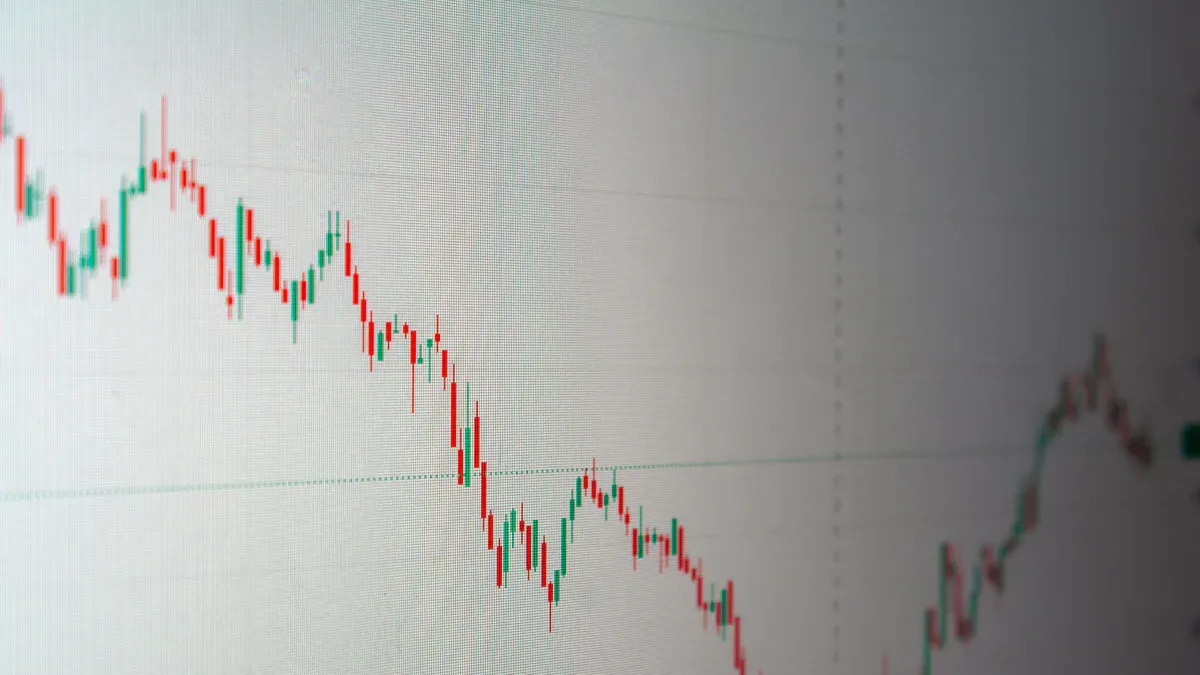- EasyCard
- Trade
- Help
- Announcement
- Academy
- SWIFT Code
- Iban Number
- Referral
- Customer Service
- Blog
- Creator
Don't Want to Get Lost in Investing? Secondary Market Data Helps You Optimize Decisions and Have More Certainty!

Image Source: pexels
Do you often feel lost when investing? Information asymmetry and emotional swings can lead to poor choices. Secondary market data empowers you to understand market behavior, assess asset correlations, and make confident decisions. Hedge fund managers often analyze historical market data to uncover relationships between economic indicators and stock performance, adjusting portfolios to mitigate risks. By leveraging data scientifically, you can invest with clarity and avoid common pitfalls.
Key Highlights
- Secondary market data helps you understand market behavior, evaluate asset correlations, and boost decision-making confidence.
- Analyzing trading volume and price trends allows you to gauge market activity and choose optimal buy/sell timings.
- Industry sector data reveals growth areas, enabling you to seize opportunities and optimize asset allocation.
- Regular analysis of secondary market data sharpens market sensitivity and reduces investment risks.
- Combining multiple data sources helps you avoid emotional decisions, stay rational, and focus on long-term goals.
Introduction to Secondary Market Data

Image Source: unsplash
Definition and Characteristics
Secondary market data refers to trading information generated when investors buy and sell assets after their initial issuance. This includes prices, trading volumes, and fund flows, offering insights into market activity and asset popularity. Unlike primary market data, which comes from initial issuances like IPO prospectuses, secondary market data reflects real-time trading dynamics. The table below outlines key differences:
| Feature | Primary Market Data | Secondary Market Data |
|---|---|---|
| Data Collection | Direct from source (e.g., surveys, interviews) | Relies on existing data (e.g., reports, publications) |
| Cost and Time | High cost, time-intensive | Faster, more budget-friendly |
| Specificity | Tailored, specific insights | Broader market or industry view |
| Data Freshness | Typically up-to-date | May rely on outdated information |
| Scope of Insights | Deep, issue-specific insights | Wider market or industry perspective |
Secondary market data provides a foundation for analyzing trends and opportunities, helping you gauge market sentiment, time trades, and reduce impulsive decisions.
Asset Types
Secondary market data covers various asset classes, primarily stocks and bonds. Stocks trade on public exchanges like the NYSE, while bonds are mostly traded over-the-counter (OTC), leading to differences in data characteristics:
| Feature | Stocks | Bonds |
|---|---|---|
| Trading Venue | Public exchanges | Mostly OTC |
| Liquidity | Generally higher | Generally lower |
| Price Transparency | High | Lower |
| Regulatory Oversight | Strict | Less stringent |
Stocks offer transparent, accessible data, ideal for real-time decisions, while bonds require more effort to analyze due to lower liquidity and transparency. Understanding these differences helps you craft data-driven strategies tailored to each asset type.
Data Types
Trading Volume
Trading volume is a key indicator of market activity and investor sentiment. Improved market sentiment boosts buyer interest and volume, especially in lead transactions. Narrowing bid-ask spreads and rising volumes signal increased liquidity and confidence. For instance, in 2023, lead transactions accounted for 55% of U.S. market volume, reflecting strong demand for quality assets.
Price Trends
Price trends help you identify market directions and predict future movements. Trend analysis techniques, like time-series and regression models, use historical data to forecast prices. Financial analysts build accurate stock models by dissecting price components, enabling you to stay ahead of market shifts and adjust strategies promptly.
Fund Flows
Fund flow data reveals capital movements, impacting short- and long-term strategies. Short-term inflows often signal “smart money,” boosting fund performance, while long-term inflows may dilute returns. Inflows also influence corporate investments and stock issuances, shaping market dynamics.
Industry Sector Performance
Industry sector data highlights growth areas using metrics like revenue growth, market share, customer acquisition, and CAGR:
| Metric | Description |
|---|---|
| Revenue Growth | Percentage increase in sales over time |
| Market Share | Company’s share of total industry sales |
| Customer Acquisition | Number of new customers gained |
| CAGR | Average annual growth rate over a period |
Other Key Data
Volatility and turnover rates provide additional insights. Higher volatility correlates with faster, stronger price reversals, while lower turnover indicates more persistent reversals. High-frequency trading data captures micro-fluctuations, helping you pinpoint critical moments and anomalies. Integrating these data types offers a comprehensive market view, enhancing decision accuracy.
How Secondary Market Data Guides Investments
Optimizing Decisions
Market volatility and information gaps can cloud judgment. Secondary market data enables rational analysis, reducing emotional trades. For example, surging trading volume and rising prices often indicate high market interest, signaling optimal trading moments. U.S. investors use trend analysis to set stop-loss and target levels, minimizing risks. Data-driven approaches help hedge funds adjust portfolios based on economic indicators, and you can adopt similar methods to stay composed and invest confidently.
Tip: Use professional data platforms to track real-time market dynamics and improve decision efficiency.
Discovering Opportunities
Secondary markets reveal opportunities unavailable in primary markets. They offer access to assets with proven performance, lower investment minimums, and greater liquidity for flexible trading. In the U.S., the secondary market, or “aftermarket,” is where securities trade post-issuance, enabling you to spot undervalued assets like bonds or stocks for higher returns.
Understanding Market Dynamics
Secondary market data helps you track industry rotations and market trends. By analyzing sector trading volumes, price changes, and fund flows, you can identify growing or declining industries. U.S. investors monitor sector performance to capitalize on rotations in tech, healthcare, or renewables, adjusting portfolios to seize opportunities and control risks.
Regularly analyze secondary market data to sharpen market awareness and stay ahead of trends.
Data Acquisition and Analysis

Image Source: pexels
Data Sources
Reliable data is critical for investment success. U.S. investors access platforms like Statista, Mintel, and Nielsen for market reports, while academic sources like Google Scholar and JSTOR offer research insights. Commercial databases like Bloomberg Terminal and Factiva provide real-time company and industry data, ideal for rapid decisions.
| Source | Description |
|---|---|
| Statista | Offers extensive market data and infographics |
| Mintel | Provides consumer goods and services research |
| Nielsen | Delivers consumer behavior and media analytics |
Tip: Cross-verify data from multiple sources to ensure accuracy.
Basic Analysis Techniques
Start with methods like literature reviews to understand market trends, benchmarking to compare company performance, and data mining to uncover hidden patterns. Style and global indices track stock and regional performance, while volatility and custom indices monitor market fluctuations and strategy outcomes.
| Technique | Description |
|---|---|
| Literature Review | Summarizes existing research for market insights |
| Benchmarking | Compares company performance to identify strengths |
| Data Mining | Uses statistical tools to uncover trends |
| Style Index | Tracks specific stock styles for decision-making |
| Global Index | Monitors regional performance for diversification |
| Volatility Index | Measures market fluctuations for risk management |
| Custom Index | Tracks specific portfolio or strategy performance |
Advanced Trading Strategies
For superior performance, use advanced strategies like day trading for short-term gains, swing or position trading for mid- to long-term trends, and trend-following or contrarian approaches for market alignment or reversals. Advanced analytical tools enable real-time data updates, with automated models predicting portfolio outcomes and stress tests ensuring resilience across market conditions.
- Day Trading
- Swing Trading
- Position Trading
- Trend Following
- Contrarian Trading
Combine basic and advanced methods to refine strategies and boost decision accuracy.
Practical Applications
Stock Selection and Timing
Secondary market data optimizes stock selection and timing, as seen in U.S. case studies:
- Airbnb’s 2017 stock buyback enabled pre-IPO liquidity. Analyzing buyback data helps gauge valuation and sentiment.
- Spotify’s 2018 direct listing allowed free trading. Volume and price data reveal optimal trading moments.
- Uber’s SoftBank deal highlighted liquidity. Transaction data shows large trades’ price impacts.
- Palantir’s reference price issuance simplified trading. Comparing reference and actual prices assesses market confidence.
- SPACs like DraftKings and Virgin Galactic offered exit opportunities. SPAC data uncovers emerging industry prospects.
- Robinhood’s auction-style sales involved pricing by employees and investors. Auction data reflects demand.
Risk Management
Secondary market data supports risk control. Large institutions view secondary exposure as a core portfolio component, acquiring discounted assets during downturns to reduce losses. Historical data shows secondary investments yield better risk-adjusted returns and lower loss ratios. Monitor liquidity, price volatility, and fund flows to adjust portfolios proactively.
Tip: Regularly track data to spot risks early and adjust strategies.
Sector Rotation
Use secondary market data to capitalize on sector rotations. Analyze trading volumes, price trends, and fund flows to identify growing or declining sectors, such as U.S. tech, healthcare, or renewables. Adjust allocations to capture opportunities and mitigate risks.
Common Pitfalls and Precautions
Data Interpretation Traps
Low liquidity in some securities can lead to losses when exiting positions, and market volatility driven by news or economic shifts affects asset values. Inadequate research increases risks. Cross-reference data sources and review public disclosures to avoid superficial judgments.
Use tables to compare asset liquidity and volatility for clearer risk assessment.
- Liquidity Risk: Some securities are hard to trade quickly, risking losses.
- Market Volatility: Prices fluctuate with news or sentiment.
- Insufficient Research: Lack of transparency requires thorough data collection.
Emotional Risks
Emotions like fear or anxiety can lead to impulsive selling during downturns, missing long-term gains. Behavioral finance highlights cognitive biases like loss aversion, herding, or overconfidence that drive irrational choices. Stay calm and stick to your investment plan.
- Fear and anxiety trigger poor decisions.
- Loss aversion overemphasizes short-term fluctuations.
- Cognitive biases like herding increase irrationality.
Avoiding Herd Mentality
Market hype can tempt you to follow trends blindly. Rely on credible financial news and expert analysis, distinguish short-term noise from long-term trends, and establish a disciplined evaluation process to avoid impulsive trades. Regular strategy reviews ensure focus on long-term goals.
- Verify information from reliable sources.
- Differentiate short-term noise from long-term trends.
- Use structured decision-making to curb impulsiveness.
- Review strategies periodically for disciplined investing.
Combine data-driven analysis with rational judgment to steer clear of emotional and herd-driven decisions.
Data-driven investing helps you manage risks and avoid biases, delivering more stable long-term returns. Low-cost funds often outperform high-cost ones, diversified portfolios reduce losses, and data-driven platforms can boost annual performance by 20%.
| Long-Term Benefits | Description |
|---|---|
| Discounted Assets | Buy mature fund shares below NAV, reducing uncertainty |
| Lower Blind Pool Risk | View underlying portfolios for informed decisions |
| Shorter J-Curve | Skip early stages for quicker returns |
Secondary market data enhances confidence and flexibility, ensuring more secure and informed investing with continuous learning.
FAQ
What is secondary market data?
It’s trading information from investor transactions post-issuance, including prices, volumes, and fund flows.
How do I access reliable secondary market data?
Use exchange websites, platforms like Statista or Bloomberg Terminal, or academic sources like Google Scholar.
Can secondary market data reduce investment risks?
Yes, by analyzing trends and liquidity, you can adjust portfolios to control risks effectively.
Do I need expertise to analyze this data?
Basic analysis is accessible with tools and learning; advanced strategies benefit from deeper knowledge.
Is secondary market data better for short-term or long-term investing?
It suits both: short-term traders focus on price fluctuations, while long-term investors analyze sector trends and flows.
Armed with secondary market data insights like volume, price trends, and fund flows, you’re poised to sidestep emotional pitfalls, yet steep commissions, cross-border transfer hassles, and currency volatility often block turning analysis into trades—especially when spotting sector rotations. Envision a platform with 0.5% fees, same-day global transfers, and instant fiat swaps, granting U.S. stock access without offshore accounts? This empowers data-informed execution.
BiyaPay is tailored for data-savvy investors, enabling seamless fiat-to-digital conversions for agile capital moves. With real-time exchange rate query, track USD fluctuations and remit at optimal moments to trim costs. Spanning most regions with instant arrivals, it fuels swift positioning in undervalued assets. Key advantage: access U.S. and Hong Kong stocks through a single account, enhancing portfolio tweaks with live data.
From sector analysis to risk mitigation, BiyaPay streamlines your edge. Sign up now, visit stocks for U.S. prospects—quick setup launches data-powered investing. Join discerning traders and harness secondary data for real results!
*This article is provided for general information purposes and does not constitute legal, tax or other professional advice from BiyaPay or its subsidiaries and its affiliates, and it is not intended as a substitute for obtaining advice from a financial advisor or any other professional.
We make no representations, warranties or warranties, express or implied, as to the accuracy, completeness or timeliness of the contents of this publication.




Contact Us
Company and Team
BiyaPay Products
Customer Services
is a broker-dealer registered with the U.S. Securities and Exchange Commission (SEC) (No.: 802-127417), member of the Financial Industry Regulatory Authority (FINRA) (CRD: 325027), member of the Securities Investor Protection Corporation (SIPC), and regulated by FINRA and SEC.
registered with the US Financial Crimes Enforcement Network (FinCEN), as a Money Services Business (MSB), registration number: 31000218637349, and regulated by FinCEN.
registered as Financial Service Provider (FSP number: FSP1007221) in New Zealand, and is a member of the Financial Dispute Resolution Scheme, a New Zealand independent dispute resolution service provider.




















